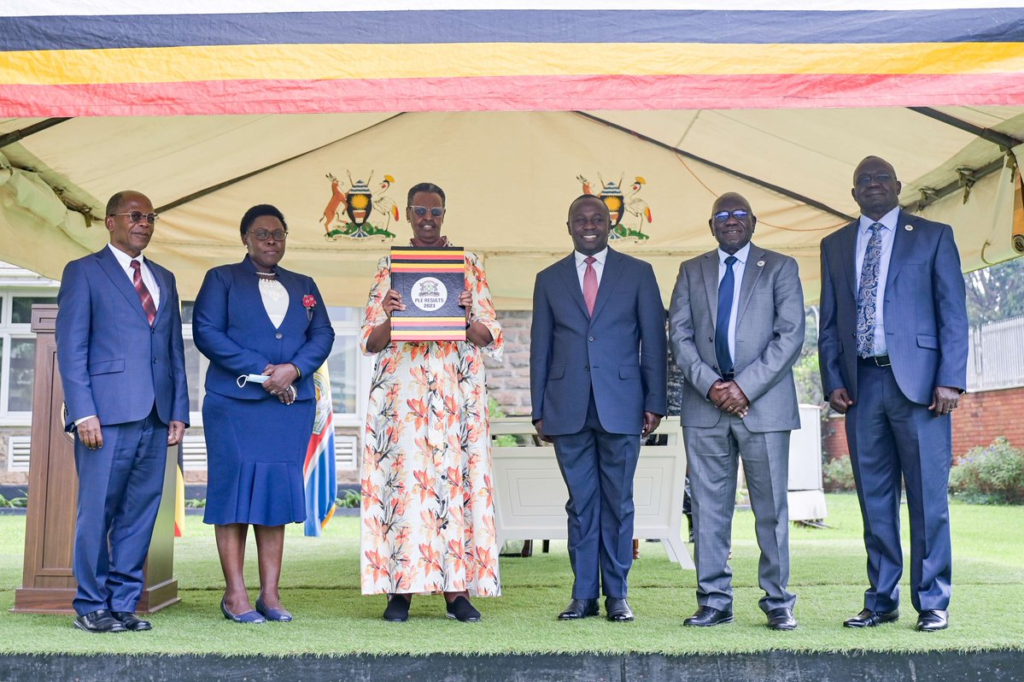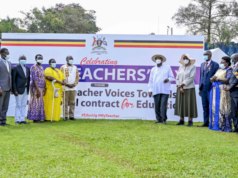
The 2023 Primary Leaving Examinations have been released, indicating a drop in performance in all subjects compared to 2022.
Speaking at the release of the results at State House Nakasero on Thursday, 25 January 2024, UNEB Executive Director Dan Odongo said the number of candidates in division 2 and 3 went down, with a higher proportion of the 2023 candidates in Division 3 and above.
“In Science and Mathematics, the overall performance indicates that more of our candidates passed proportionally those two subjects,” he said.
“A higher proportion of the 2023 candidates passed in Division 3 and above level. Overall, the performance of candidates is comparable to that of 2022. Division U (Ungraded) is awarded to candidates who have failed to reach the minimum level of performance that can be awarded at least a Division 4 They are not eligible for admission to the Senior 1 class,” he added.
“It should be noted that the number of candidates in Division U is quite high, at 88,269 (10.4%) and should raise concern so that they do not just add to the statistics of school drop-outs. There are districts such as Kibuku (31.5o), Madi Okollo (31.5%), Dokolo (28.9%), Kween (28.4%), Namisindwa (28.9%) where the percentages are well above the national average. Many other districts have over 20% of the candidates in Division U. It is necessary to find out the causes and address them,” he added.
A total of 749,254 candidates from 15,859 centres (schools) registered for PLE in 2023 compared to 832,654 in 2022. Of this number, 501,602 (66.9%) from 11,365 centres were Universal Primary Education (UPE) beneficiaries, and 247,652 (33.1) of the candidates were Non UPE.
However, the results released by the examination body show that more than 91.0 percent of the candidates which is 670.607 of total 736,931 of those who sat the examinations successfully passed science, achieving at least a Pass eight.
This marks an improvement from last year’s 89.6 percent. Remarkably, science garnered the highest number of distinctions, with 72,219 candidates, representing 9.8 percent of the total, achieving at least distinction two in the subject.
In mathematics, 85.3 percent of the candidates passed the subject and attained at least a Pass 8, a notable increase from the 80.7 percent recorded last year. Additionally, there was improvement in English, although the percentage of candidates achieving distinctions one and two in the subject dropped from 12.2 percent of the registered candidates to 7.8 percent.

Performance in social studies remained comparable to that of the previous year; however, this time, fewer learners were able to pass the subject at distinction levels. Social studies emerged as the second-best-performed subject at distinction levels, with 9.4 percent of candidates successfully achieving distinction one and two.
Proportionally males performed better than the females. According to the results, 47,452 boys were in Division One, representing 13% compared to 39,130 girls in Division One, representing 9.99%. A total of 164, 906 boys (46%) boys were in Division Two compared to 171, 601 (43%) girls. 69,870 boys (19.53%) were in grade 3 while 86,420 (22.07%) girls were in the same grade.
Girls performed better than boys in English, where 90.64% passed English compared to the boys who are 88.32% but the reverse is true for the other three subjects; SST, Science, and Mathematics.

Meanwhile, the number of learners who register for Primary Leaving Examination (PLE) and fail to turn up on the examination day has steadily decreased to the lowest point.
During the release of the examination results on Thursday afternoon, Mr. Dan Odongo, the Executive Director of the Uganda Examinations Board, noted that last year’s examination saw the lowest number of absentees in the last five examination cycles.
According to UNEB’s analysis of the 2023 examination results, out of the 749,254 candidates who were registered for the examination, 1.6 percent of them which is total of 12,323 pupils, did not appear for the exam.
The trend for absentee candidates indicated a slight reduction. In the 2020 examination cycle, which took place in 2021 due to COVID-19 disruptions, the number of absentees decreased to 1.7 percent of the registered candidates. However, in 2022, there was a sharp increase, with 20,844 out of the 832,654 registered candidates, accounting for 2.5 percent, failing to turn up.
Often, students who register but do not attend the examination include those who become ill or incapacitated and are unable to participate. Additionally, some students are refused the opportunity to sit the exam by school authorities due to unpaid school fees balances. Furthermore, there are instances where students arrive late at the examination center and are consequently denied entry, in adherence to regulations, among other reasons.
During the same event, Janet Kataaha Museveni, the Minister of Education and Sports, expressed her satisfaction that the negative trend of absentee candidates in PLE has been reversed. However, she acknowledged that the figure of over 12,000 absentee candidates is still substantial.
She emphasized that those who fail to attend represent a significant loss as some may drop out of education, not to mention the resources incurred by the government and their parents.
According to the report, Wakiso district recorded the highest number of absentees in the primary leaving examination, with a total of 850 candidates out of 65,081 registered candidates failing to show up on the examination day. In Kampala, 382 candidates did not turn up, while in Kayunga, 256 candidates were absent.
On the other hand, Kaberamaido and Kalangala had the lowest absentee rates, with just one candidate failing to turn up in each district. Other districts with fewer absentees included Moyo and Kween, each having only four candidates, and Kalaki with three absentee candidates.
During the release of the examination results, the Minister of Education and Sports also expressed concern over the ongoing decline in the number of boys completing primary education in Uganda.
While Uganda has made significant progress in achieving gender parity in access to primary education for both boys and girls over the years, records from UNEB reveal that more girls are completing the primary education cycle.
UNEB statistics show 391,499 registered female candidates compared to 357,755 males. Odongo noted that this trend has persisted for the last seven years, with the gap gradually widening each year.
“Why is the boy child not completing Primary?” questioned the First Lady, urging concerned parties to prescribe solutions that can address the fundamental causes and prevent this negative trend.
While there is a growing concern about boy children, especially when the country has focused efforts on girls, it’s important to contextualize the idea of whether boys complete their education or not. This is particularly noteworthy considering that more girls are enrolling in school than boys.
According to the United Nations Population Fund’s State of the World Population report released in 2020, over six percent of the adjusted net enrollment of boys in primary education between 2009 and 2018 never attended school, compared to three percent for girls with Uganda’s gender parity index stands at 1.03 in favor of females.
The selection exercises of Senior one will take place on Thursday 1st and Friday 2nd February while the first term for Senior one students of 2024 will begin on Monday February 19th.






